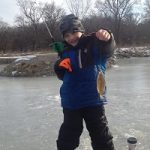by Winding Pathways | Jun 22, 2017 | (Sub)Urban Homesteading, Amphibians/Reptiles, Garden/Yard, Nature
Every once in a while, when we’re out in our summery yard enjoying birds and flowers, we encounter a snake. We’ve been around snakes for decades and know there are no venomous species in our area but we’re still startled when one slithers away.
Managing a yard to attract a diversity of wildlife sometimes encourages snakes to move in along with birds and butterflies. Usually the snakes that visit yards are non-venomous species merely looking for a place to live and something for dinner. Most common are garter snakes that mostly eat insects. We’ve written about garter snakes on Winding Pathways before. Sometimes we spot tiny brown snakes no bigger than a nightcrawler. They also eat worms and bugs. Once in a while we see a beautifully colored and patterned fox snake. They probably seek tasty white footed mice or maybe a chipmunk. And lots of folks combat the undermining work of chipmunks.
Some backyard snakes can be downright startling. A few years ago, we spotted a husky snake that held its ground. It hissed loudly and was not willing to flee. Although looked threatening, we knew it was just an act. It was a hog nosed snake that sometimes flattens its head like a cobra and hisses when a human approach. It’s a trick that works. Most people quickly back off from this imposing act. This snake loves eating toads and frogs but won’t bite people.
There’s an irony about snakes. Many homeowners simply hate chipmunks. Yet they’ll kill any snake they find. Snakes are one of the best of all chipmunk predators and having a few around keeps the population of the small mammals in check.
Snakes range throughout the continental United States. Most species are non-venomous and even in places where venomous snakes live they generally avoid suburban and urban neighborhoods. It’s good to be cautious but be curious instead of terrified. When a snake is spotted give it plenty of space and try to identify it.
Identify Snakes
Binoculars that focus closely is a help in observation. And you can keep your distance. Concentrate on the shape of the head and tail, the color(s) and scale patterns and type of habitat. Google a guide to snakes of (name your state) for more information. The snake is likely harmless and fascinating. If it is not, then you might have to have it destroyed.
This is the case in some parts of the country. We have friends who live in the breaks of central Idaho where rattlers periodically come in. So, they are very aware as they move around the garden and yard.
We consider the snakes we occasionally find in our Winding Pathways yard as interesting and welcome as the goldfinches and cardinals that visit our feeders. We’ve even placed a few hollow logs at the edge of the yard so they have a a safe place to hide. They also enjoy a rock wall between our house and a patch of trees.
If we’re not sure what species of snake we’ve discovered we often go to the Internet. Many state universities have Websites that help people identify the snake species that live there. Iowa has a great site. So, does Florida, and an interesting one comes from Nebraska. Many field guide books are also on the market that feature color photos and information about snake species.
Tips
Wildlife Specialist Rebecca Christoffel of Iowa State University Extension reminds us that “…snakes eat worms, slugs, bugs and other small animals such as frogs or fish. Snakes don’t do any damage to buildings because they don’t dig their own holes, instead using holes other animals have made.” She has a few simple tips to remove a snake from areas of the yard where homeowners do not want them. If a snake is found in an undesirable place, like a garage or shed, Christoffel said a broom and a trash barrel can easily be used to remove it. Lay the trash barrel on its side, and with a broom (soft plastic bristles or straw), “sweep” the snake into the garbage barrel, gently forcing it down to the bottom of the barrel. The barrel, and snake, can then be taken to another area of the property and the snake released out of harm’s way.” (From ISU website)
Christoffel added, “An alternative solution is to learn to accept having the snakes around and appreciating the valuable ecosystem services they provide,” Christoffel added. “Snakes are excellent rodent and insect control.”
Find a snake in the yard? You may be startled. Remember, be cautious and curious. It’s likely a desirable and beautiful species that helps keep a balance of wildlife. After all, snakes, too, have a place in the eco-system.
by Winding Pathways | Jan 20, 2017 | Amphibians/Reptiles, Children/Play, Nature, Wonderment
Almost all substances contract as they get colder. There’s one notable exception and it enables life.

Ice expands and floats
As water cools, it gets denser. As the temperature continues to drop, cold surface water sinks to the bottom. When the lake’s surface water reaches 39 degrees Fahrenheit something amazing happens. As weather continues to get colder it expands. When it turns to ice it expands even more! That’s why ice floats. If it didn’t, ponds and lakes would completely freeze and nothing could live in a solid block of ice.
Ice floating on a lake moderates the temperature of the water beneath it. Although the air temperature may be below zero above the ice the water beneath it is never below freezing. That’s why fish, frogs, and other aquatic organisms can not only live but also bask in the relative warmth of the water while terrestrial animals are forced to survive in arctic cold.
This phenomenon makes ice fishing possible. The following blog was written by a friend who took her children fishing one cold morning.
Ice Fishing With Kids
Story and photos of people
by: Kelly Carr
“They weren’t budging. Even with the overhead light flipped on, gentle shoulder shakes, and promises of the fun they would have, my kids feigned sleep. It was 7:00 a.m. on New Year’s Eve, and it had been about a year since our last ice fishing attempt. This particular day was the sixth of a seven day stretch of the new shared-custody arrangement I had with my daughter and son’s father. As if putting them through a divorce wasn’t guilt-inducing enough, now I was trying to drag them out of the security of their warm beds. My mind drifted back to the present – if I could just get them going, I knew they would have a great time. So, I played the “Let’s Get Donuts On The Way” card. Sleeping forms shifted, eyelids sprung open. We were out the door in fifteen minutes, teeth unbrushed, bedhead tucked under stocking caps, and feet snuggled into a double layer of socks.”
Donut Bribery works!
“I’ve tried to raise kids who feel comfortable in nature. Driving to the park for the ice fishing clinic, the car filled with the smell of maple frosting. I mused silently upon some of our past outdoor adventures. We have been geocaching newbies, tramping at a roadside park, looking for a “small bison container”, which, as it turned out, was NOT a buffalo figurine after all! We’ve packed picnics into cemeteries, and talked oaks and stones and stories while we ate.
“A voice from behind jostled me back to the present. I passed a cappuccino to waiting hands in the backseat and then pointed up to a hillside, “Look – a cemetery!” My daughter protested, “Not today, Mom! Ugh!” You win some, you lose some.
The Outdoor Thing
“We wound through the park to the shore. After a quick presentation by a naturalist and distribution of fishing guides, bait and poles, we were set. My kids chose spots not too far away from their last year’s spots, got settled in on mats and sipped from their gas station cups while waiting for spring-bobbers to bob. The sun made things sparkle, and as I looked at them handling things and sitting in peace, I knew I had nothing to feel guilty about. Tummies full, bundled in warm layers, taking a chance on adventure, we were doing this “outdoors thing”. And we were finding our new “normal” while doing it. They each pulled two fish out of the water that morning before asking to go back to the car to listen to music. I consider that as success.

Smiles

A warm bed is no match for the coolness of catching a panfish in winter.
“I had a few moments to myself out on the ice, to take it all in. Even when life changes, there are constants we can count on. The fish may not always bite, but while the sky is above and the earth (or ice) is below, I am a mother who loves her kids.”
by Winding Pathways | Mar 13, 2016 | Amphibians/Reptiles, Birds, Nature, Travel/Columns
After an unusually mild winter we were hardly surprised by the early onset of spring’s symphony. At Winding Pathways in Iowa it usually starts on clear cold February days when male cardinals begin their beeker beeker beeker call. They were close to their normal schedule this late winter. Then red winged blackbirds arrived fully two weeks early and added their voices to roadside ditches and wetlands.
On March 7 we heard the glorious sound that truly harkens spring – Chorus Frogs and Peepers! We were driving a dirt road through southern Iowa’s Shimek State Forest when Marion heard the voices of dozens of tiny frogs coming from a puddle the size of our car.
Chorus Frogs
To naturalist Joseph Wood Krutch singing peepers heralded a true resurrection and marked the start of the warm season. Living in Connecticut he noted that they always began singing in the period of time in which Easter can fall. In other words between March 22 and April 25 .
That’s usually true in Iowa but this year they are earlier, much earlier.
Most people have heard peepers and chorus frogs but have never seen the tiny amphibians that sing with magnificent enthusiasm. The two species often live in the same places and can be easily told apart by their calls. Chorus frogs sound like a person running his finger along the teeth of a comb, while peepers make the “peep peep peep” calls that gives them their name. To hear recorded peepers and chorus frogs log in to Manitoba Frog and Toad Calls.
Frogs are far from the only animals that begin calling as winter transitions into spring. Migrating birds are already beginning to appear in yards, woodlands, and wetlands across America and often they are easier to hear than see. Some of the most melodic singers are the hardest birds to spot, and identifying them by sound is often more efficient than trying to spot a bird in thick brush. The Cornell Lab of Ornithology has excellent audios of bird calls for mobile apps.
Experienced birders (and froggers for that matter) use both ears and eyes to identify species. Like many birders we started out using printed bird guides to help us learn species. Only much later did we begin learning their calls. It’s been a rewarding hobby that has a cruel catch.
Each Rich would learn new bird calls when history caught up with him. Probably due to intense noise of heavy machine guns in Army training decades ago his ability to hear many sounds, particularly those of high pitches is fading. Marion can hear birdsong he can’t. He’s investigating hearing aids that should help him continue this fascinating means of identification. Stay tuned. He’ll report on hearing aids later.
USING THE MERLIN APP
For years we lugged around bird books that were either large and heavy or compact but limited in the information they provided. They were the best way to learn new species in the field.
That’s changed thanks to the Cornell Laboratory of Ornithology. We loaded their free Merlin App into our smart phones. It makes identifying 400 bird species a snap. At the touch of a few keys several photos of each species appear, a range map, and……best of all…… recorded sounds of each bird.
We still carry and refer to a paper bird book but the Merlin App has become our favorite field tool for identifying birds, especially by their call.
ABOUT THE LABORATORY OF ORNITHOLOGY
We joined the Lab a few years ago and love its colorful and informative magazine, LIVING BIRD, and the many bird tips posted on their websiteChorus Frogs. The Lab has been a leader in bird science for decades and they’ve helped us become better birders and gain new insights into the lives of these fascinating animals.
by Winding Pathways | Aug 22, 2015 | Amphibians/Reptiles, Nature
Many Iowans, even those living in urban areas, may be startled to see a fast moving snake in their yard. No worries. Most likely it is a garter snake. While startling to see, they are a desirable predator in yards and natural places. They are easily identified by it s small head and the three stripes running down its body. The name may be a misspoken form of German or refer to ‘garters’ that people used to use to hold up stockings. At any rate, they are interesting, helpful , and thus, desirable reptiles to have in the yard.
Garter snakes eat snails, worms, insects, small rodents, and nearly any other animal life they discover. However, they are also on the list of prey for other predators from raptors to other snakes. So this petite species normally flees when it detects danger. They also can emit a foul smell when threatened. Females give birth to as many as 70 babies in late summer or fall. These six inch mini snakes can be common in yards. Most do not survive because other predators gobble them up. So if you see one slithering under leaves or a rock to get out of danger, let it be. It helps keep the balance of nature in your yard.
Many species of garter snake inhabit North America. Three species – the common and plains garter snakes and the ribbon snake – live in Iowa. All have slender bodies with lines extending from head to tail. These native reptiles thrive in a diversity of habitats but usually prefer living in moist places near streams or in well-watered gardens. They are excellent swimmers and move quickly and gracefully over the ground.
The common garter snake ‘s range is wide spread and more cold tolerant than most reptiles and even inhabits southern Alaska. In Iowa they are sometimes spotted in late fall after other snakes have entered hibernation.
Of all snakes the garter is the one most likely to be seen in town. Although they startle humans this colorful and shy wild animal is no more harmful or dangerous than goldfinches or cottontails. Winding Pathways encourages folks to respect and thank them for the part they play in keeping the balance of nature.
by Winding Pathways | May 4, 2015 | (Sub)Urban Homesteading, Amphibians/Reptiles, Garden/Yard, Nature
The annual evening toad serenade has begun! From May into summer rural and urban folks can enjoy the loud trilling announcing toad lovemaking season. Nature’s summer music.
As amphibians, toads require standing water to reproduce but unlike many frogs they don’t need watery abundance. Toads lay their eggs in small pools that often dry up by summer. Eggs hatch quickly into tiny black tadpoles. While bullfrog tadpoles take two years to change into adult frogs, toad tadpoles are speedsters that transform into tiny hopping miniature adults by mid-summer. Often hundreds of these tiny creatures can be spotted seeking cool damp places to live.
Toads are voracious insect eaters, and gardeners delight in having them live under squash vines or tomato plants. Some people even construct tiny toad homes to encourage them to live in the garden.
We’re lucky to have a big toad living in a shed near our garden. His home is damp and cool with plenty of insects to keep him well fed.
According to the National Wildlife Federation, when pestered, toads eject a watery toxic substance from the parotoid glands. The toxin discourages dogs, raccoons or other hungry varmints intent on a meal from eating them. Few predators bother the placid toad. This bufotoxin can cause an allergic reaction in people. But humans do NOT get “warts” from toads.
Homeowners can encourage toads to take up residence. Building a small pond creates a toad magnet and maintaining a few damp places in the garden will provide toad homes. Avoid insecticides and, thus, encourage worms and insects for these intriguing animals to gorge on.
Kids love toads. When our children, Dan and Nancy, as small children delighted in watching them in our small backyard pond. Toads help transform a boring yard into a wondrous one!



